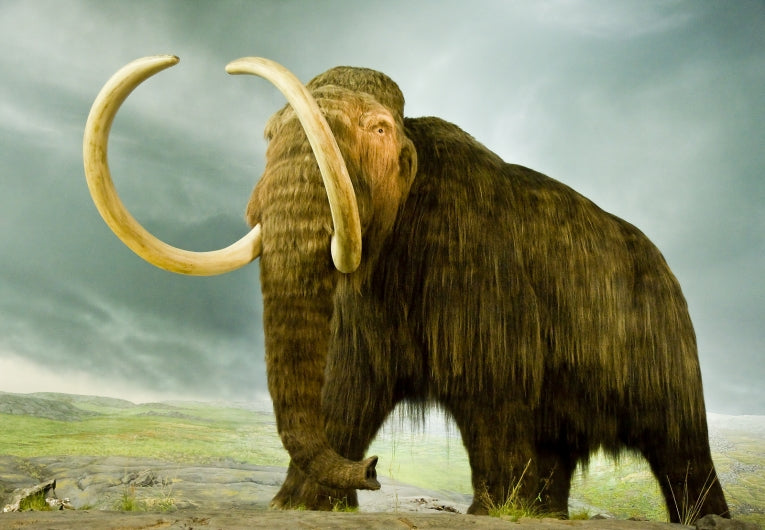The frozen and preserved remains of a shaggy monster that lived in Siberia at -40°C 10,000 years ago have been uncovered; they are of course those of a mammoth (Mammuthus primigenius). A remote island was their last bastion 4000 years ago but now the permafrost reveals many of their secrets in more detail than any other extinct animal species. And what killed them? The mystery was investigated in a BBC/Discovery collaboration, watchable on BBC iPlayer in the UK.
The young mammoth, known as 'Yuka', was approximately two and a half years old when killed by lions or humans. Strawberry blonde hair, her tail lost, she lay in an ancient bog, pickled quickly in the peat acid, then frozen solid. All kinds of creatures were alleged to have produced the giant bones of mammoths but in 1728 scientists finally realised they were elephants with a hump and with muscles to carry those huge tusks. Extreme Pleistocene climate had caused the evolution of such northern hairy elephants, in many forms to adapt to varying habitats.
The earth, at its furthest from the Sun, had entered a cold phase which happens every 10,000 years. Ice sheets formed, 13,000 feet thick, in the north of Europe, America and of course Siberia. Only the tops of mountains peered over these sheets, and the "mammoth steppe" was created in sunny and unclouded conditions, with water being tied up in the great ice formations. Elephants took to the steppe and ate trees and shrubs.
Then, six million years ago, the largest mammoth species evolved at up to 4m tall. Tails and ears shrank in size. Woolly mammoths however, were only the size of an Asian elephant. Four specialised molar teeth evolved to eat the steppe grass, enabling a habitat even further north, beyond the tree line. Yuka had a tool at the end of her trunk, like the rest of her species. This pulled up tufts of grass and shrubs, with very large kidneys, just like those of camels because the dry conditions demanded special adaptation for water retention.

Yuka the mammoth; Credit: F Latreille/Mammuthus/MCE
A French explorer and researcher, Dr Bernard Buigues, found Yuka by a Siberian river-mouth, working with native peoples of the area. Unprecedented melting now reveals hundreds of mammoth carcase, but he found this one especially well preserved Now a tundra, the Siberian steppe is full of geophysicists and palaeontologists from Japan, the US, Russia, as well as France. The huge 125kg tusks interest some, growing throughout the mammoth's life, creating a record of thin layers. Comparing whole populations of tusks, it's almost as if the mammoths were a living species to be studied. We now know more than many living species from those tusks. Dan Fisher, at the University of Michigan Museum of Natural History, studies tusk internal structure by carefully splitting them open. Polished and viewed in UV light, the cross-sections give a beautiful insight into a life long ago.
Alternative research shows how isotopes of oxygen can illustrate water sources and nitrogen isotopes can show up the protein source. Carbon isotopes show plants eaten and how much, disclosing how winter starvation was extensive in many growth lines. Weaning is simple to pinpoint in the tusk sections. The tusks also show that teenage males were cast out to forage, while mature males starved during must. Battles between rival males are revealed in tusk damage.
Only microscopic amounts of DNA are left on the skeletons, including all the bacteria that lived on the animals. No usable DNA is therefore often found in bone, but mammoth hair is plentiful. Shampooed and bleached and digested, the hair, even at 18,000 years old, can have 90% of the DNA left. The genome shows 4 different "races" of this species. Research has also shown the recreated blood of mammoth. It doesn't decrease its oxygen capacity at the low temperatures the mammoth had to endure. That increased oxygen-offloading ability was one of the essential physiological changes evolved especially for this species, just like the Yuka kidney.
Cloning the mammoth has been an aim of Japanese scientists for several years. They discovered almost intact bone marrow from a thigh bone in Yakutsk and hope to use a female elephant for what is obviously more than a simple experiment within the next 5 years.
With tusks twice as long as an elephant, why did the mammoth become extinct? Warming after the Pleistocene ice, and the resultant cloudy skies and wet tundra caused a population crash 30,000 years, but the species recovered. Dan Fisher believes a predator was responsible for the later decline. The species developed younger maturation and shorter calving intervals in an effort to survive this predation. There was no evidence for one predator until Bernard Buigues found a baby mammoth's corpse on the shore of the Arctic Ocean. Yuka was 3 or 4 years old, but had at least 10,000 years buried in the ice. The spine, skull and tusks had been removed, obviously by human activity, but it is thought that the mammoth had been killed originally by lions. Such a new mystery competes with those lofty cloning ambitions. Who and when is the most pertinent question on this distant crime against mammoths. What on earth did humans want as its meat was not eaten? Perhaps future research will find that out.










